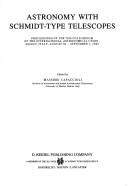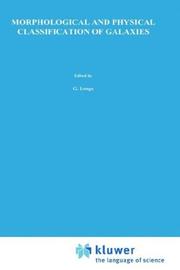| Listing 1 - 10 of 11 | << page >> |
Sort by
|
Book
ISBN: 3031547608 Year: 2024 Publisher: Cham : Springer Nature Switzerland : Imprint: Springer,
Abstract | Keywords | Export | Availability | Bookmark
 Loading...
Loading...Choose an application
- Reference Manager
- EndNote
- RefWorks (Direct export to RefWorks)
The book is about the “space race”, starting from the earliest steps of astronautics to the Moon landings of Armstrong and Aldrin. The conquest of space began as a by-product of an exquisitely military project, the rapid, and efficient delivery of explosives, conventional and then nuclear, over great distances into enemy territory. It happened at the turn of World War II, first with the V2s, the Wunderwaffen that von Braun had created for his Führer, and, after the surrender of Germany and Japan, with the intercontinental ballistic missiles that the Russians and Americans built to serve as cabs for atomic bombs. Restrained by the fear of nuclear holocaust, the two great powers that had momentarily divided the government of the world turned the risky muscular confrontation into an unusual race to climb the sky: a stage race with a conventional finish line marked by the human landing on the Moon. Under the constant guidance of Sergei Korolev, the mysterious “chief designer”, the Soviets got off to a surprise start and stayed in the lead until almost the end, with the Sputniks, the orbital flights of Gagarin and Tereshkova, the first spacewalk, and the unmanned soft landings on the Moon and Venus, only to be caught up and overtaken by the Americans at the very edge. An adventure that lasted a total of twelve years, marked by brilliant and courageous men, by astute and far-sighted politicians, by patriotism and ambition, and, as always, regulated by luck, which profoundly affected our world and the design of its future.
Outer space --- Astronautics. --- Physicists --- Astronomers --- Physics --- Space Exploration and Astronautics. --- Biographies of Physicists and Astronomers. --- History of Physics and Astronomy. --- Exploration. --- Biography. --- History.
Book
ISBN: 9789811249273 9789811247774 Year: 2024 Publisher: Hackensack, N.J. : World Scientific,
Abstract | Keywords | Export | Availability | Bookmark
 Loading...
Loading...Choose an application
- Reference Manager
- EndNote
- RefWorks (Direct export to RefWorks)
Today we know much about the sky: how stars are born, how they live and die, and how the universe as a whole evolves. We have learned of the existence of another type of matter, indifferent to light and yet decisive for the formation of galaxies, and we have a hint of a dark energy that since the last 4.5 billion years has taken over the control of the cosmos. We postulated and then discovered and even photographed black holes and listened to the faint rustle of the space-time ripple produced when these monsters devour each other. We reached these astonishing results (recognized by a bunch of Nobel Prizes and filling every day the media with wonders for the eyes and the mind) by the marriage of physics and astronomy that unified the Earth with the sky and then by the leap forward of science and technology in the Twentieth Century. This rich heritage has ancient roots. It was built by accumulating discoveries with errors, observations with fantasies, myths, and superstitions with flashes of genius, over a span of millennia, since Homo sapiens, turning his eyes to the immutable and perfect sky, began to ask questions. The book is a narration of the answers to these questions that had evolved over time: a progressive path, inserted in the general history, with some second thoughts and many obstacles. This is a saga of men and machines where greatness sometimes mixes with misery and passion often borders on sacrifice and even martyrdom. Why should we know it? Because our current knowledge is the result of these efforts and of the preconceptions that accompanied them. The challenge has been to present this complex and intricate subject without resorting to any formulas, so that it can be accessible to a wide audience of curious people, including high school and university students and in general all those who normally keep themselves informed of scientific things. A rich bibliography has also been added in the appendix for those wishing to learn more on one or more topics
Astronomy --- Astronomie --- History. --- Histoire. --- Copernicus, Nicolaus, --- Kepler, Johannes, --- Brahe, Tycho, --- Galilei, Galileo, --- Cassini, Giovanni Domenico, --- Huygens, Christiaan, --- Bradley, James, --- Newton, Isaac, --- Herschel, William, --- Rosse, William Parsons, --- Fraunhofer, Joseph von, --- Kirchhoff, G. --- Huggins, William, --- Hale, George Ellery, --- Aristarchus, --- Leavitt, Henrietta Swan, --- Copernic, Nicolas, --- Cassini, Jean-Dominique, --- Parsons, William, --- Kirchhoff, Gustav, --- Aristarque de Samos,
Digital
ISBN: 9788847026407 Year: 2012 Publisher: Milano Springer Milan
Abstract | Keywords | Export | Availability | Bookmark
 Loading...
Loading...Choose an application
- Reference Manager
- EndNote
- RefWorks (Direct export to RefWorks)
Pure sciences. Natural sciences (general) --- Astrophysics --- Astronomy --- Geophysics --- Physical geography --- wetenschapsgeschiedenis --- astrofysica --- fysische geografie --- geofysica --- astronomie

ISBN: 9027717567 9400963890 9400963874 Year: 1984 Volume: vol 110 Publisher: Dordrecht Boston Lancaster Reidel
Abstract | Keywords | Export | Availability | Bookmark
 Loading...
Loading...Choose an application
- Reference Manager
- EndNote
- RefWorks (Direct export to RefWorks)
Schmidt telescopes --- Congresses. --- Schmidt telescope --- Congresses
Multi
ISBN: 9783031547607 9783031547591 9783031547614 Year: 2024 Publisher: Cham Springer Nature Switzerland :Imprint: Springer
Abstract | Keywords | Export | Availability | Bookmark
 Loading...
Loading...Choose an application
- Reference Manager
- EndNote
- RefWorks (Direct export to RefWorks)
Space research --- Astronomy --- Physics --- fysica --- ruimte (astronomie) --- ruimtevaart
Book
ISBN: 9290920459 Year: 1992 Volume: 1152
Abstract | Keywords | Export | Availability | Bookmark
 Loading...
Loading...Choose an application
- Reference Manager
- EndNote
- RefWorks (Direct export to RefWorks)
52 --- #TWER:WTCM --- Astronomie. Astrofysica. Ruimteonderzoek. Geodesie
Book
ISBN: 9788847026407 Year: 2012 Publisher: Milano Springer Milan
Abstract | Keywords | Export | Availability | Bookmark
 Loading...
Loading...Choose an application
- Reference Manager
- EndNote
- RefWorks (Direct export to RefWorks)
La scienza è un'esaltante avventura che è costume raccontare attraverso le gesta dei grandi. Esiste però un'altra storia, altrettanto avvincente ma con poca voce, scritta dai tanti gregari e potenziali campioni cui la sorte, spesso nemmeno troppo cieca, ha negato la gloria. Questo libro parla di uno di loro e del suo piccolo mondo sulla collina di Capodimonte, a Napoli. È la parabola di Arminio Nobile - personaggio notevole eppure poco noto dell'astronomia italiana - svolta sulla scena della nascente astrofisica, in una stagione di grandi transizioni per il Mezzogiorno. Arminio, che era figlio di Giuseppina Guacci, figura di spicco della cultura pre-risorgimentale, e di un valente astronomo della Specola di Capodimonte, scelse di votarsi allo studio del cielo. Osservatore instancabile, appassionato e genialoide, aveva le carte in regola e le motivazioni per sfondare , ma la fortuna non gli arrise: più volte si beffò di lui, spingendolo su vicoli ciechi che la sua testardaggine gli impedì di abbandonare. Così, quando la grande occasione gli si parò davanti, la riconobbe ma non seppe coglierla appieno, morendo disperato come il pucciniano amante di Tosca.
Pure sciences. Natural sciences (general) --- Astrophysics --- Astronomy --- Geophysics --- Physical geography --- wetenschapsgeschiedenis --- astrofysica --- fysische geografie --- geofysica --- astronomie
Multi
ISBN: 9783031045769 9783031045752 9783031045776 9783031045783 Year: 2022 Publisher: Cham Springer International Publishing :Imprint: Springer
Abstract | Keywords | Export | Availability | Bookmark
 Loading...
Loading...Choose an application
- Reference Manager
- EndNote
- RefWorks (Direct export to RefWorks)
This book provides an introduction to classical celestial mechanics. It is based on lectures delivered by the authors over many years at both Padua University (MC) and V.N. Karazin Kharkiv National University (EB). The book aims to provide a mathematical description of the gravitational interaction of celestial bodies. The approach to the problem is purely formal. It allows the authors to write equations of motion and solve them to the greatest degree possible, either exactly or by approximate techniques, when there is no other way. The results obtained provide predictions that can be compared with the observations. Five chapters are supplemented by appendices that review certain mathematical tools, deepen some questions (so as not to interrupt the logic of the mainframe with heavy technicalities), give some examples, and provide an overview of special functions useful here, as well as in many other fields of physics. The authors also present the original investigation of torus potential. This book is aimed at senior undergraduate students of physics or astrophysics, as well as graduate students undertaking a master's degree or Ph.D.
Mathematics --- Space research --- Astronomy --- Classical mechanics. Field theory --- Geophysics --- zwaartekracht --- toegepaste wiskunde --- wiskunde --- ruimte (astronomie) --- astronomie --- dynamica
Book
ISBN: 997150636X Year: 1989 Publisher: Singapore London Hong Kong World Scientific
Abstract | Keywords | Export | Availability | Bookmark
 Loading...
Loading...Choose an application
- Reference Manager
- EndNote
- RefWorks (Direct export to RefWorks)
Astronomy --- Astrophysics --- Astronomy. --- Astrophysics. --- Vaucouleurs, Gérard Henri de, 1918 --- -Vaucouleurs, Antoinette de.

ISBN: 0792317122 Year: 1992 Publisher: Dordrecht Boston London Kluwer Academic
Abstract | Keywords | Export | Availability | Bookmark
 Loading...
Loading...Choose an application
- Reference Manager
- EndNote
- RefWorks (Direct export to RefWorks)
| Listing 1 - 10 of 11 | << page >> |
Sort by
|

 Search
Search Feedback
Feedback About UniCat
About UniCat  Help
Help News
News